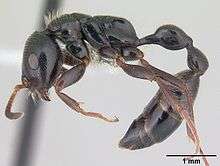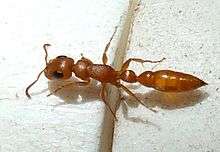Tetraponera
| Tetraponera | |
|---|---|
 | |
| Tetraponera rakotonis worker | |
| Scientific classification | |
| Kingdom: | Animalia |
| Phylum: | Arthropoda |
| Class: | Insecta |
| Order: | Hymenoptera |
| Family: | Formicidae |
| Subfamily: | Pseudomyrmecinae |
| Genus: | Tetraponera Smith, 1852 |
| Type species | |
| Tetraponera atrata Smith, 1852 | |
| Diversity[1] | |
| 101 species | |
Tetraponera, is a genus of ants, commonly slender ants, in the family Formicidae, and are characterised by their arboreal nature and slender bodies. The 86 described species of Tetraponera all live in hollow structures of plants and trees, such as thorns or branches; these hosts are known as myrmecophytes. Tetraponera species are closely related to the New World genus of ants Pseudomyrmex, but differ in their relationships with host plants.
Mutualisms and behaviour
Tetraponera species are generally defined by the myrmecophytes they inhabit and the mutualistic relationship they share.[2] These host plants always have hollow thorns or branches in which the ants can live and form a colony. Also, the myrmecophytes provide energy rich food sources such as extrafloral nectar and/or food bodies. All Tetraponera species have gut symbionts that allow them to digest amino acid-deficient food provided by their host plants; these gut bacteria are especially important for the species that only survive on the myrmecophyte-provided foods.
All Tetraponera species provide protection for their host plants through aggressive nature towards other insects and trimming leaves/branches of neighbouring plants. Living in hollow structures of the plants allows the ants to detect vibrations when larger insects land on the plant, or workers on patrol visually detect smaller intruders. Once detected, sophisticated pheromone systems allow the ants to quickly outnumber and overpower any invaders. Most insect invaders are killed and discarded by Tetraponera workers such as caterpillars and aphids, but some are killed and consumed. The insects that take the most time and effort to kill are generally consumed; these are mostly katydids or leaf beetles.
As well as assaulting and killing insects that attack their host plant, Tetraponera ants will attack any mammals that present a threat. Inflicting the mammals with painful stings will usually deter them from attacking the plant.
In some arboreal ant species, not just Tetraponera, a third partner in ant-myrmecophyte mutualisms is hemipteran trophobionts. These insects provide a possible third source of food for the ants, in return the ants feed and “nurture” the Hemiptera inside their colonies.
Distribution
Tetraponera species are found commonly in the warmer regions of Africa, Asia, and Australia. Different species are associated with different plant species. The most common myrmecophytes for Tetraponera are acacias, but the wide variety of hosts for this genus include bamboos and lianas. Tetraponera ants trim neighbouring plants to prevent any intrusion of other ants or caterpillars from those plants and to reduce resource competition for their host. Tetraponera species only leave their myrmecophyte to start a new colony on a different host; a queen and a number of workers leave the old host plant to allow the colony to continue to expand.
Lifecycle and castes

Tetraponera, like most ants, has one or a few queens that are the only females to reproduce in a colony. The sterile workers are all females that forage for food and defend the colony. Males are produced only during certain times of the year and disperse to mate with virgins queens from other colonies. Since ants are haplodiploid, they can control what sex their offspring will be; an unfertilised egg will become a male, while a fertilised egg will be female. This reliably restricts the production of male alates to the species' mating season, when the winged virgin queens and males fly from their home colonies to mate and start new colonies.
The eggs produced by the queen hatch into larvae which are cared for inside the colony, protected from any predators by the workers. The amount of care each female larva receives determines its fate as a worker or a new queen; all males are drones. When a new colony is formed, eggs are initially produced at a low rate, but this quickly increases in the second to fourth years, to ensure enough workers are produced to protect and provide for the growing colony.
Species
- Tetraponera aethiops Smith, 1877
- Tetraponera aitkenii (Forel, 1902)
- Tetraponera allaborans (Walker, 1859)
- Tetraponera amargina Xu & Chai, 2004
- Tetraponera ambigua (Emery, 1895)
- Tetraponera andrei (Mayr, 1895)
- Tetraponera angusta (Arnold, 1949)
- Tetraponera anthracina (Santschi, 1910)
- Tetraponera apiculata Ward, 2001
- Tetraponera arrogans (Santschi, 1911)
- Tetraponera atra Donisthorpe, 1949
- Tetraponera attenuata Smith, 1877
- Tetraponera avia Ward, 2001
- Tetraponera binghami (Forel, 1902)
- Tetraponera bita Ward, 2001
- Tetraponera braunsi (Forel, 1913)
- Tetraponera brevis Ward, 2001
- Tetraponera buops Ward, 2001
- Tetraponera capensis (Smith, 1858)
- Tetraponera carbonaria (Smith, 1863)
- Tetraponera claveaui (Santschi, 1913)
- Tetraponera clypeata (Emery, 1886)
- Tetraponera concava Xu & Chai, 2004
- Tetraponera conica Ward, 2001
- Tetraponera connectens Ward, 2001
- Tetraponera convexa Xu & Chai, 2004
- Tetraponera crassiuscula (Emery, 1900)
- Tetraponera demens (Santschi, 1911)
- Tetraponera diana (Santschi, 1911)
- Tetraponera difficilis (Emery, 1900)
- Tetraponera emacerata (Santschi, 1911)
- Tetraponera emeryi (Forel, 1911)
- †Tetraponera europaea Dlussky, 2009
- Tetraponera exasciata (Forel, 1892)
- Tetraponera extenuata Ward, 2001
- Tetraponera fictrix (Forel, 1897)
- Tetraponera flexuosa (Santschi, 1911)
- Tetraponera furcata Xu & Chai, 2004
- Tetraponera gerdae (Stitz, 1911)
- Tetraponera grandidieri (Forel, 1891)
- †Tetraponera groehni Dlussky, 2009
- Tetraponera hespera Ward, 2009
- Tetraponera hirsuta Ward, 2009
- Tetraponera hysterica (Forel, 1892)
- Tetraponera inermis Ward, 2009
- Tetraponera inversinodis Ward, 2001
- †Tetraponera klebsi (Wheeler, 1915)
- †Tetraponera lacrimarum (Wheeler, 1915)
- Tetraponera laeviceps (Smith, 1859)
- Tetraponera latifrons (Emery, 1912)
- Tetraponera ledouxi Terron, 1969
- Tetraponera lemoulti (Santschi, 1920)
- Tetraponera liengmei (Forel, 1894)
- Tetraponera manangotra Ward, 2009
- Tetraponera mandibularis (Emery, 1895)
- Tetraponera mayri (Forel, 1901)
- Tetraponera merita Ward, 2009
- Tetraponera microcarpa Wu & Wang, 1990
- Tetraponera mimula Ward, 2001
- Tetraponera minuta (Jerdon, 1851)
- Tetraponera mocquerysi (André, 1890)
- Tetraponera modesta (Smith, 1860)
- Tetraponera monardi (Santschi, 1937)
- Tetraponera morondaviensis (Forel, 1891)
- Tetraponera natalensis (Smith, 1858)
- Tetraponera nigra (Jerdon, 1851)
- Tetraponera nitida (Smith, 1860)
- Tetraponera nixa Ward, 2001
- Tetraponera nodosa Ward, 2001
- Tetraponera notabilis Ward, 2001
- †Tetraponera ocellata (Mayr, 1868)
- †Tetraponera oligocenica (Théobald, 1937)
- Tetraponera ophthalmica (Emery, 1912)
- Tetraponera parops Ward, 2006
- Tetraponera penzigi (Mayr, 1907)
- Tetraponera perlonga Santschi, 1928
- Tetraponera petiolata Smith, 1877
- Tetraponera phragmotica Ward, 2006
- Tetraponera pilosa (Smith, 1858)
- Tetraponera plicatidens (Santschi, 1926)
- Tetraponera polita Ward, 2001
- Tetraponera poultoni Donisthorpe, 1931
- Tetraponera prelli (Forel, 1911)
- Tetraponera protensa Xu & Chai, 2004
- Tetraponera punctulata Smith, 1877
- Tetraponera rakotonis (Forel, 1891)
- Tetraponera rotula Ward, 2001
- Tetraponera rufipes (Jerdon, 1851)
- Tetraponera rufonigra (Jerdon, 1851)
- Tetraponera sahlbergii (Forel, 1887)
- Tetraponera schulthessi (Santschi, 1915)
- Tetraponera scotti Donisthorpe, 1931
- †Tetraponera simplex (Mayr, 1868)
- Tetraponera tessmanni (Stitz, 1910)
- Tetraponera thagatensis (Forel, 1902)
- Tetraponera triangularis (Stitz, 1910)
- Tetraponera tucurua Ward, 2001
- Tetraponera variegata (Forel, 1895)
- Tetraponera vivax Ward, 2001
- Tetraponera volucris Ward, 2001
- Tetraponera zavattarii (Menozzi, 1939)
References
- ↑ Bolton, B. (2014). "Tetraponera". AntCat. Retrieved 17 July 2014.
- ↑ Young, T.P.; Cynthia H. Stubblefield; Lynne A. Isbell (December 1996). "Ants on swollen-thorn acacias: species coexistence in a simple system". Oecologia. 109 (1): 98–107. doi:10.1007/s004420050063. Retrieved 2008-01-21.
- Borm, S.V., A. Buschinger, J. J. Boomsma and J. Billen. 2002. Tetraponera ants have gut symbionts related to nitrogen-fixing root-nodule bacteria. Biological Sciences. 269:2023-2027.
- Ward, P.S. 2001. Taxonomy, phylogeny and biogeography of the ant genus Tetraponera (Hymenoptera:Formicidae) in the Oriental and Australian regions Invertebrate Taxonomy. 15:589:665.
- Dejean, A., J. Orivel and C. Djieto-Lordon. 2008. The plant ant Tetraponera aethiops (Pseudomyrmecinae) protects its host myrmecophyte Barteria fistulosa (Passifloraceae) through aggressiveness and predation. 93:63-69.
- Australian Biologicla Resources and Study: Australian Faunal Directory. http://www.environment.gov.au/biodiversity/abrs/online-resources/fauna/afd/taxa/Tetraponera
External links
 Media related to Tetraponera at Wikimedia Commons
Media related to Tetraponera at Wikimedia Commons